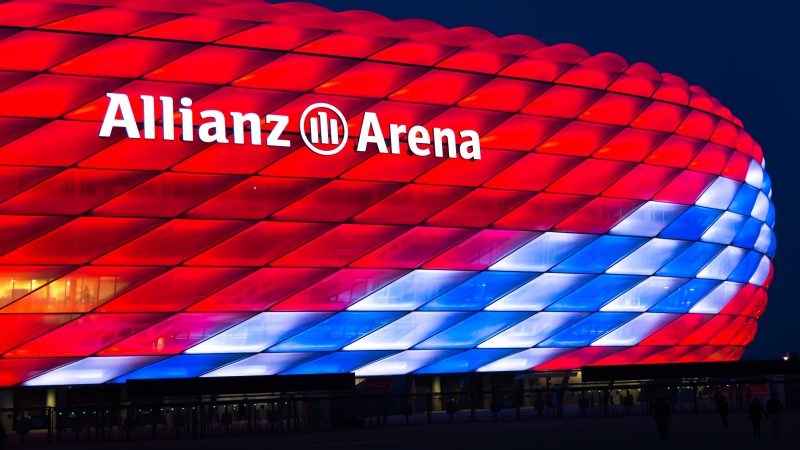Munich’s Allianz Arena: a paragon of climate neutrality?

28
MayBy: ian
Comments: 0
Munich’s Allianz Arena: a paragon of climate neutrality?
By: Nikolaus J. Kurmayer | EURACTIV.de
This article is part of EURACTIV’s special report Euro 2021 football cup: The green issue.
The Euro 2020 football cup’s carbon footprint has come under green scrutiny because of the logistics required to move the teams around between the eleven organising countries. Is the Munich stadium part of the problem or part of the solution?
The Allianz Arena in Munich will host at least four games of the Euro 2020. As climate protection issues become ever more important to Europeans, fans are wondering whether football is doing its share in fighting climate change.
The German initiative Zukunft Profifußball (the future of professional football) has made headlines by demanding that football clubs own up to their ecological responsibilities.
German football events have a history of laying claim to sustainability, starting with the 2006 world championships, which organisers considered climate neutral thanks to its ‘Green Goal’ initiative.
“With the 2006 World Cup we have shown that major events can also be organised in an environmentally sound way,” said then German environment minister Sigmar Gabriel.
The flagship measure implemented back then was a 100,000-tonne carbon offset scheme to compensate the event’s emissions with carbon reduction projects like tree-planting initiatives. Organisers also committed to cut waste generation and water use by 20%.
But those initiatives were largely dismissed by environmental groups. “Offsetting projects simply don’t deliver what we need – a reduction in the carbon emissions entering the atmosphere,” said Alia al Ghussain of Greenpeace UK.
Greenpeace probably have a point. Football events have tended to be rather generous in estimating their own climate impacts. At the 2006 world cup in Germany, the Oko-institute estimated the added carbon emissions due to spectator and team travel at around 100,000 tonnes of CO2 for the entire event.
For the 2016 UEFA Euro cup hosted in France, UEFA estimated the CO2 emissions due to spectator and team travel at around 517,000 tonnes.
It is unclear whether spectator and team mobility emissions increased five-fold in the 10-year period between the 2006 world cup in Germany and the 2016 Euro cup in France. But the discrepancy in CO2 emissions between the two events certainly shows that estimates can vary widely.
‘Climate-neutral Allianz Arena 2030’
Following the 2006 world cup, the Allianz Arena and its resident team, Bayern Munich, are now again coming under the spotlight.
Judging by official declarations, ecological sustainability has become a major consideration for FC Bayern. “FC Bayern has a vision: the climate-neutral Allianz Arena 2030,” said Andreas Jung, head of marketing at FC Bayern München AG and shareholder representative of the Allianz Arena.
“We have been dealing with environmental issues since 2002 already,” said Jürgen Muth, executive officer of Allianz Arena, adding that the stadium has a long history of working towards climate neutrality.
FC Bayern began implementing an Eco-Management and Audit Scheme (EMAS) in 2006, in a bid to reduce the stadium’s carbon footprint and cut down costs. EMAS is open to anyone fulfilling the requirements and serves as a management and controlling tool.
According to the public records required by the EMAS scheme, the arena’s renewable energy use jumped from 26% in 2017-18 to 69% in 2018-19. In 2019, FC Bayern won the European Reusable Award granted by the environmental NGO Environmental Action Germany (DUH) due to its introduction of reusable plastic cups.
“By using reusable cups, FC Bayern München is therefore leading the way, demonstrating that in football stadiums, environmental protection and entertainment can go hand in hand,” said DUH deputy executive director Barbara Metz.
The arena also supplements its energy use with solar panels totaling 750 kW peak capacity and constantly seeks to optimise its energy use for heating and cooling.
Room for improvement
There is still plenty of room for improvement though, starting with water use. In 2018-2019, the arena used upwards of 60 million litres of water. With 2.26 million visitors that year, this means more than 2,600 litres of water was used for each visitor.
Energy consumption is another area where further gains can be made. The arena seats a whole 70,000 people during international games and can boast almost 8,000 square meters of culinary space, all of which requires vast amounts of energy for heating and cooling.
And then of course, there is transport. For every game that is hosted at the arena in normal times, more than 30,000 spectators arrive by car or bus, travelling upwards of 270km on average. The arena alone offers upwards of 11,000 parking spots for cars and buses in massive parking complexes.
On average, just under 50% of spectators reach the stadium by public transport, meaning further gains there are possible.
Germany’s Euro 2024 will be ‘most sustainable in history’
Looking forward, UEFA has signed up to the EU’s 2050 climate neutrality goal. And with the Euro 2024 taking place in Germany, the Allianz Arena will once again aim to make climate neutrality a core part of its ambitions.
“As co-organisers of the 2024 UEFA European Championships, we want to make the tournament the most sustainable and climate friendly in Euro history,” said Phillip Lahm, managing director of Euro 2024 GmbH.
[Edited by Frédéric Simon]
